Op. 22 Lemminkäinen (Four legends)
No. 1 Lemminkäinen and the Maidens of Saari. First version 1895; first performance in Helsinki, 13th April 1896 (Orchestra of Helsinki Philharmonic Society under Jean Sibelius). Second version 1897; first performance in Helsinki, 1st November 1897 (Orchestra of Helsinki Philharmonic Society under Jean Sibelius). Final version 1939.
No. 2 (until 1947 no. 3) The Swan of Tuonela. First version 1895; first performance in Helsinki, 13th April 1896 (Orchestra of Helsinki Philharmonic Society under Jean Sibelius). Second version 1897; first performance in Helsinki, 1st November 1897 (Orchestra of Helsinki Philharmonic Society under Jean Sibelius). Final version 1900.
No. 3 (until 1947 no. 2) Lemminkäinen in Tuonela. First version 1895; first performance in Helsinki, 13th April 1896 (Orchestra of Helsinki Philharmonic Society under Jean Sibelius). Second version 1897; first performance in Helsinki, 1st November 1897 (Orchestra of Helsinki Philharmonic Society under Jean Sibelius). Final version 1939.
No. 4 Lemminkäinen’s Return. First version 1895; first performance in Helsinki, 13th April 1896 (Orchestra of Helsinki Philharmonic Society under Jean Sibelius). Second version 1897; first performance in Helsinki, 1st November 1897 (Orchestra of Helsinki Philharmonic Society under Jean Sibelius). Final version 1900.
For Sibelius, Lemminkäinen - or the Lemminkäinen Suite as it is more frequently called - meant a return to large-scale orchestral works after a crisis which centred round the writing of an opera. Soon after the unenthusiastic reception of the first performance of En Saga Sibelius read Wagner's essay Oper und Drama. It convinced him that music without words cannot satisfy mankind. He was planning an opera with a libretto by J. H. Erkko, based on the 8th and 16th runes of Kalevala.
The opera was The Building of the Boat, for which Sibelius had the following outline: the young Väinämöinen (called Väinö or Wäinö in letters and libretto drafts) sees the Daughter of the Moon in the blood-red evening sky and falls in love. The Daughter of the Moon promises to marry Väinö if he will sing together a boat from the pieces of a spindle. In the second scene Väinö tries in vain to sing together a boat. He does not have the necessary magic words to build the boat. In the third scene Väinö goes to Tuonela (i.e. the land of the dead) to ask for the words. While Väinö is half-asleep he receives the three words from Tuonetar, Queen of Tuonela. In the closing scene Väinö is sailing on the lake in his new boat and singing of his love. The sky turns red, the Daughter of the Moon appears and the lovers meet.
Sibelius recollected that he completed the overture to the opera at his summer residence in Ruovesi, in 1893. From the overture he later prepared The Swan of Tuonela, which is part of the Lemminkäinen Suite. The planning of the opera was interrupted by a commissioned work, the Karelia music. Towards the end of the year he showed the libretto sketch to Kaarlo Bergbom, who was an influential figure in Finnish theatrical and operatic circles. However, Bergbom did not consider the motif dramatic enough for the stage.
Sibelius did not give up. In July 1894 he went to see the poet Paavo Cajander, who was spending his summer near Hämeenlinna. Sibelius had dug out his opera draft and wanted to add more dramatic material to the text.
In the autumn of 1998 the musicologist Markku Hartikainen found Sibelius's manuscript for the second libretto draft of The Building of the Boat (among Cajander's papers in the archives of the Finnish Literature Society). It seems that the composer asked Cajander to write a new libretto on the basis of this draft. The draft is considerably more dramatic and scenically more rewarding than the previous plot.
The first act has not survived. The second act contains striking crowd scenes in which Wäinö and the villagers quarrel, and Wäinö reveals his idealism and uncertainty. In the third scene Wäinö meets the Daughter of Death in the underworld and makes her fall in love with him. She saves him from the underworld spirits whose singing has made him defenceless. In the last act Wäinö rows his magic boat to Luonnotar (Daughter of Nature) - not Kuutar, Daughter of the Moon, as previously - and fervently declares his love. However, Luonnotar turns out to be cold and distant. Wäinö gives up his dream and decides to live alone.
This plot was now sufficiently eventful and dramatic for a stage work. To strengthen his faith in the opera the composer travelled to the Wagner Festival in Bayreuth in the summer of 1894. He quickly gave up his worship of the German composer, but admitted at the same time that Parsifal and
Tristan and Isolde were such overwhelming works that for a brief period he felt it impossible to continue his career as a composer
Sibelius broke away from Wagner by becoming absorbed in the works of Liszt. “I think that I am really a musical painter and poet. I mean that Liszt’s musical standpoint is the one that comes closest to me. That [concept of a] symphonic poem. At the moment I am working on a subject which is very dear to me. I will tell you when I come back," he wrote to Aino on 19th August 1894.
It is likely that the "dear subject" mentioned in the letter is the first form of the Lemminkäinen Suite, which began to take shape from the fragments of The Building of the Boat. In 1935 Sibelius told his biographer Karl Ekman on two different occasions that the work that he was writing in Munich was Lemminkäinen. But according to the musicologist Veijo Murtomäki, Sibelius could also have meant
The Wood Nymph.
On returning home the composer continued to prepare his work over several months The overture for the opera The Building of the Boat now became the The Swan of Tuonela. Sibelius had decided to change the programmatic concept of the work to describe Lemminkäinen's adventures. In an adapted form, the music for Väinö's journey to Tuonela was very suitable for Lemminkäinen in Tuonela. Indeed, there is a mention of the Daughter of Death in the drafts for Lemminkäinen in Tuonela. This looks back to the draft for the opera.
It is not known to what extent the opening piece, Lemminkäinen and the Maidens of Saari, and the splendid finale, Lemminkäinen’s Return, are based on the plan for the opera. In 1896 there were already other influences. "The first movement was in sonata form - the whole thing was intended as a programme symphony," the composer recollected later, adding that he had been inspired by the symphonic poems of Hector Berlioz. Berlioz's La Damnation de Faust had been a great favourite of the Helsinki audience in the years 1894 and 1895.
In early April 1896 Sibelius started the orchestra rehearsals of his Lemminkäinen Suite. Once again the orchestra found the music difficult and almost rose up in rebellion, exactly as in the first rehearsals for Kullervo and En Saga. During the rehearsals the composer's wife wept behind the door as she listened to the quarrelling.
The critic Karl Flodin wrote that "Sibelius has managed to avoid the great misfortune of repeating himself" and was pleased that the work had moved away from "the Finnish style". However, he considered the cor anglais solo in The Swan of Tuonela
"stupendously long and boring". He questioned the way Sibelius
"mesmerises the listeners with atmosphere, modulation and hypnotic violence, which they have to succumb to, unless they brace themselves – to leave the concert hall".
The Finnish-speaking critic Oskar Merikanto praised the Finnish atmosphere of the work. "In Lemminkäinen we admire a mature composer, an artist who has achieved mastery in every respect, and a composition, which must be awarded the first place among our compositions, both in respect of its form and its content."
People were surprised by Flodin's qualified praise, but the composer himself was not completely satisfied either. He rewrote the piece and conducted its first performance on 1st November 1897. In the new version he removed the tambourine and carillon from the orchestration of Lemminkäinen and the Maidens of Saari, while adding new material in the middle part of the movement. In Lemminkäinen’s Return many of the elaborations in the material were cut out.
The concert hall was packed for the new performance, and the audience gave Sibelius thunderous ovations. Merikanto was exultant. "It was as if the audience had, for the very first time, shaken our most brilliant composer's hand with real warmth, and said to him: thank you for your works of genius; now we understand you and are proud of you!"
However, Karl Flodin astonished readers with a devastating review:
"This kind of music feels downright pathological and the impressions it leaves are so confused, painful and vague that they have very little in common with that aesthetic pleasure which all fine arts and music in particular should awaken (…)
The fact that Sibelius is a genius – that is something he has heard often enough to dare to employ his right to walk his own paths. So be it. But an art which cannot make a human being nobler and happier, if only for a moment, is certainly rocking on the crest of a wave and will sink without leaving a trace."
Sibelius was depressed. But he did believe in the merits of The Swan of Tuonela and Lemminkäinen’s Return and he kept them in his repertoire. It was with these very works as well as Finlandia and the first symphony that he made his international breakthrough at the beginning of the 20th century. But the sections Lemminkäinen and the Maidens of Saari and
Lemminkäinen in Tuonela gathered dust for decades. The composer never again conducted them himself.
Sibelius began to look again at the sections he had discarded when he received the score of Lemminkäinen from Robert Kajanus's estate in 1933. He allowed performances of the movements at the centenary of Kalevala on 1st March 1935. Now the reception was good, and the composer finally decided to allow the works to be published, after making a few corrections in 1939. But the war delayed publication, and the movements were not published until 1954. "It happened as it happened, because certain gentlemen did not like my legends," Sibelius noted.
Lemminkäinen and the Maidens of Saari starts with calls on the French horns, which often give a sense of fog-horns. The strings may be imitating the movement of the waves. The woodwinds announce thematic fragments which set the stage for the meeting of Lemminkäinen and the maidens.
This is not programmatic music in the sense that the music would follow a narrated plot. However, one can associate the dance-like theme on the woodwinds which follows the figures on the strings with "the maidens of the island".
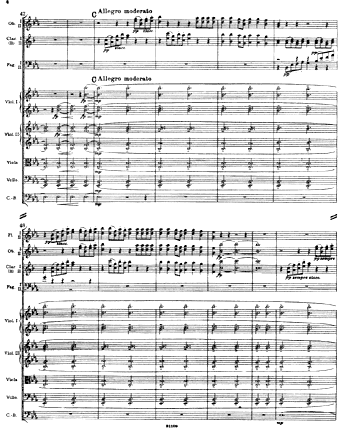
Page 4 of the score of Lemminkäinen and the Maidens of Saari. Breitkopf & Härtel.
One can also associate the following "endless melody" with the passionate Lemminkäinen - or with erotic longing in general (as pointed out by Erkki Salmenhaara). The build-up begins with a melody on the cello.
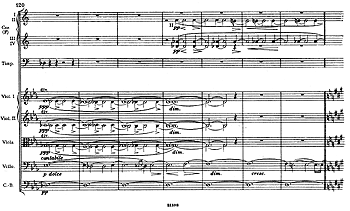
Lemminkäinen and the Maidens of Saari, excerpt from page 11.
Breitkopf & Härtel.
The build-up progresses at length, and during the development the thematic materials of the maidens and Lemminkäinen become connected to each other. As early as in Kullervo Sibelius had described physical love, leading to a resolution. Now the act is described more skilfully: instead of being violent the atmosphere is genuinely erotic, sometimes dark and longing, sometimes playful and teasing. In the coda, the atmosphere calms down.
During the 1890s Lemminkäinen in Tuonela was played as the second movement of the suite, but later Sibelius decided to replace it with The Swan of Tuonela. Nowadays conductors use both alternatives, but the original order is becoming increasingly popular.
The Swan of Tuonela is a splendid example of dark orchestration and of Sibelius's way of substituting for the pedal of the piano by means of skilful orchestration. This can be seen at the very beginning, when the composer takes the A minor triad upwards one octave at a time.

The last page of the score of The Swan of Tuonela.
Breitkopf & Härtel.
Sibelius omits the flutes, clarinets and trumpets and raises the strings to the high register, thus leaving room for a long and extremely fine cor anglais solo, which is supported by responses from the cello.
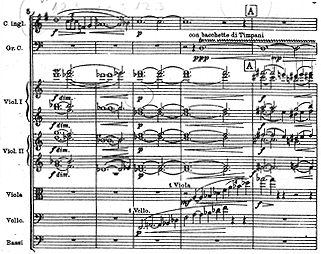
The Swan of Tuonela, excerpt from page 2.
Breitkopf & Härtel.
The music of the movement is very static. It is music that can draw the listener in, creating an almost trance-like state. The Swan of Tuonela can be seen to prefigure composers such as György Ligeti, Arvo Pärt and Kaija Saariaho who use static means to create their musical material.
Lemminkäinen in Tuonela is the most operatic music in the suite. In The Swan of Tuonela Tuonela was a place of peace and death. But now evil spirits seem to have awakened, because Lemminkäinen has dared to come to catch the swan as it floats on the sacred river of Tuonela.
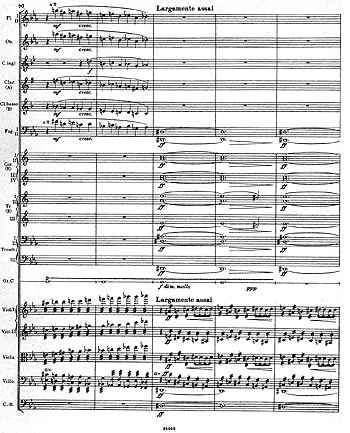
Lemminkäinen in Tuonela, page 14.
Breitkopf & Härtel.
The infernal atmosphere is created by a tremolo from the lower strings. The tempo becomes faster and the "inferno" motif is heard in the wind instruments. The theme becomes surprisingly impressionistic. Finally only repentance and death seem to remain.
Now comes a new build-up, with new resolutions from the brass. The tremolos are omitted in the largamente sequence, which leads to a middle episode realised by violins and tambourine. In the plan for The Building of the Boat this apparently portrayed the appearance of the Daughter of Death.
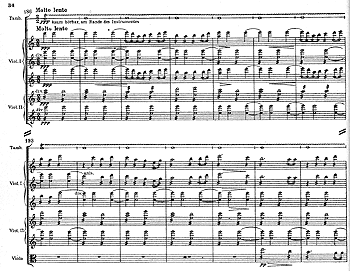
Lemminkäinen in Tuonela, excerpt
from page 34.
Breitkopf & Härtel.
The theme takes on an increasingly Finnish tone. The music now portrays Lemminkäinen's mother. "The lullaby at the end of the piece represents maternal love, which rakes up the pieces of Lemminkäinen from the river of Tuonela," Sibelius explained to his son-in-law Jussi Jalas in 1948.
The infernal tremolos in the strings return and receive resolute support from the brass. This can be seen as a struggle for Lemminkäinen, or as his awakening from the dead. The movement contains powerful music, but Erkki Salmenhaara has, with good reason, seen somewhat formulaic elements in it.
By contrast, there is nothing formulaic in the masterly finale, Lemminkäinen’s Return. The initial bassoon theme includes a three-note embryonic motif. By varying this Sibelius progresses through the entire rondo of the finale.
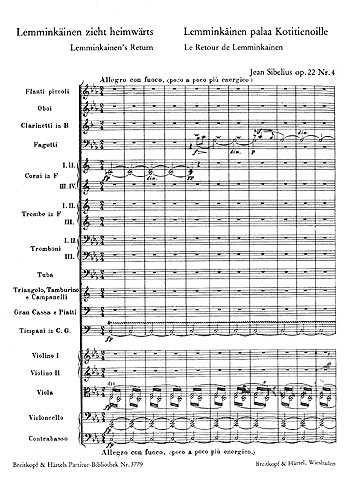
Lemminkäinen’s Return, first page.
Breitkopf & Härtel.
Sibelius's motif-based developmental technique is already masterly. From C major we progress towards "home" in E flat major - clearly via an oriental route, for the backbeat from the cymbals gives the music a oriental tone. In 1900 the critic Ferdinand Pfol of Hamburger Nachrichten also found "wrenching accents and heavy stress on the first note as favoured by Hungarian gypsies".
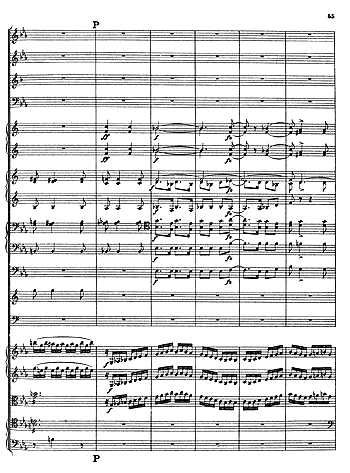
Lemminkäinen’s Return, page 55.
Breitkopf & Härtel.
Figures suggestive of horse-riding take us to the joyful end of the movement. "I would like us Finns to have a little more pride. Not to be hanging our heads! What is there to be ashamed of? This is an idea that runs through Lemminkäinen's Return. Lemminkäinen can hold his own with any count or marquis. He is an aristocrat, definitely an aristocrat," Sibelius explained in an interview in 1921.
As a whole the Lemminkäinen Suite is close to symphony: there is a first movement which utilises sonata form, a slow movement, an "infernal" scherzo and a joyful finale. In his old age Sibelius himself was inclined to emphasise the symphonic nature of his work. "I actually have nine symphonies, since some of the movements in Kullervo and Lemminkäinen are in pure sonata form," he said.
However, during the actual composition he did not want to use the term symphony. Moreover, the subtitle "four legends" implied that the works could be regarded as independent, despite forming a whole. A few years later Sibelius would indeed write his first symphony.

